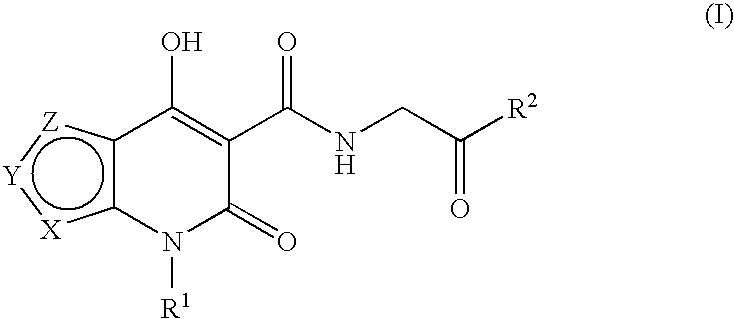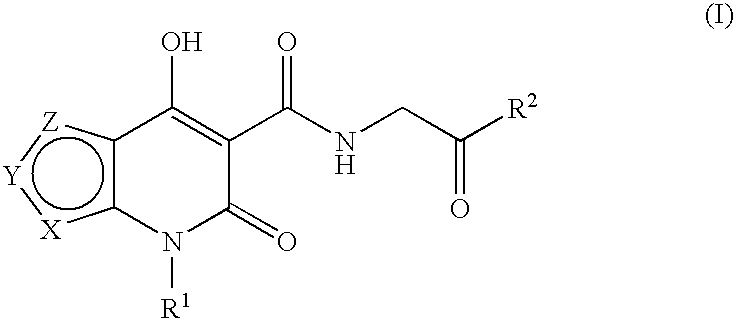Prolyl hydroxylase inhibitors
a technology of prolyl hydroxylase and inhibitor, which is applied in the direction of biocide, drug composition, extracellular fluid disorder, etc., can solve the problems of reduced oxygen levels in the blood, ubiquitination of hif-alpha and subsequent degradation, and achieve the effect of increasing the production of erythropoietin and epo
- Summary
- Abstract
- Description
- Claims
- Application Information
AI Technical Summary
Benefits of technology
Problems solved by technology
Method used
Image
Examples
example 1
[0098]
N-[(4-Hydroxy-6-oxo-6,7-dihydrothieno[2,3-b]pyridin-5-yl)carbonyl]glycine
1a) Methyl 2-{[3-(ethyloxy)-3-oxopropanoyl]amino}-3-thiophenecarboxylate
[0099]To a solution of methyl 2-amino-3-thiophenecarboxylate (2.00 g, 12.7 mmol) and triethyl amine (3.50 mL, 25.2 mmol) in methylene chloride (20.0 mL) was added ethyl 3-chloro-3-oxopropanoate (1.76 mL, 14.0 mmol) dropwise. The reaction was stirred for 3 h at ambient temperature and quenched with ice water. The mixture was extracted with ethyl acetate. The organic layer was dried over MgSO4, filtered, concentrated in vacuo, and purified via flash chromatography (0-100% ethyl acetate in hexanes) to afford the title compound as a yellow solid (1.20 g, 34%). 1H NMR (400 MHz, CHLOROFORM-d) δ ppm 12.1 (s, 1H) 7.24 (d, J=5.8 Hz, 1H) 6.78 (d, J=5.8 Hz, 1H) 4.33 (q, J=7.1 Hz, 2H) 3.94 (s, 3H) 3.62 (s, 2H) 1.34 (t, J=7.2 Hz, 3H). MS (ES+) m / e 272 [M+H]+.
1b) Ethyl 4-hydroxy-6-oxo-6,7-dihydrothieno[2,3-b]pyridine-5-carboxylate
[0100]To a solutio...
example 2
[0102]
N-{[4-hydroxy-6-oxo-7-(phenylmethyl)-6,7-dihydrothieno[2,3-b]pyridin-5-yl]carbonyl}glycine
2a) Methyl 2-[(phenylmethyl)amino]-3-thiophenecarboxylate
[0103]To a solution of benzaldehyde (0.85 mL, 8.40 mmol) and methyl 2-amino-3-thiophenecarboxylate (1.20 g, 7.60 mmol) in CH2Cl2 (20.0 mL) was added sodium triacetoxyborohydride (2.10 g, 9.90 mmol) and acetic acid (0.42 mL, 7.60 mmol). The mixture was stirred overnight at ambient temperature, quenched with water and extracted with CH2Cl2. The organic layer was dried over MgSO4, filtered, concentrated in vacuo, and purified via flash chromatography (0-100% ethyl acetate in hexane) to afford the title compound as a yellow oil (1.20 g, 64%). 1H NMR (400 MHz, CHLOROFORM-d) δ ppm 7.83 (s, 1H) 7.30-7.40 (m, 5H) 7.06 (d, J=5.81 Hz, 1H) 6.19 (dd, J=5.81, 1.01 Hz, 1H) 4.46 (d, J=5.81 Hz, 2H) 3.82 (s, 3H). MS (ES+) m / e 248 [M+H]+.
2b) Methyl 2-[[3-(ethyloxy)-3-oxopropanoyl](phenylmethyl)amino]-3-thiophenecarboxylate
[0104]Following the procedur...
example 3
[0107]
N-[(4-hydroxy-3-methyl-6-oxo-6,7-dihydrothieno[2,3-b]pyridin-5-yl)carbonyl]glycine
3a) Ethyl 2-{[3-(ethyloxy)-3-oxopropanoyl]amino}-4-methyl-3-thiophenecarboxylate
[0108]Following the procedure of Example 1a), except substituting ethyl 2-amino-5-methyl-3-thiophenecarboxylate for methyl 2-amino-3-thiophenecarboxylate, the title compound was obtained as a white solid. 1H NMR (400 MHz, CHLOROFORM-d) δ ppm 6.44 (s, 1H) 4.43 (q, J=7.2 Hz, 2H) 4.31 (q, J=7.2 Hz, 2H) 3.60 (s, 2H) 2.40 (s, 3H) 1.42 (t, J=7.1 Hz, 3H) 1.34 (t, J=7.2 Hz, 3H). MS (ES+) m / e 300 [M+H]+.
3b) Ethyl 4-hydroxy-3-methyl-6-oxo-6,7-dihydrothieno[2,3-b]pyridine-5-carboxylate
[0109]Following the procedure of Example 2c), except substituting the compound from Example 3a) for the compound from Example 2b), the title compound was obtained as a yellow solid. 1H NMR (400 MHz, DMSO-d6) δ ppm 6.71 (s, 1H) 4.31 (q, J=7.2 Hz, 2H) 2.39 (s, 3H) 1.29 (t, J=7.2 Hz, 3H). MS (ES+) m / e 254 [M+H]+.
3c) N-[(4-Hydroxy-3-methyl-6-oxo-6,7-di...
PUM
| Property | Measurement | Unit |
|---|---|---|
| weight | aaaaa | aaaaa |
| weight | aaaaa | aaaaa |
| weight | aaaaa | aaaaa |
Abstract
Description
Claims
Application Information
 Login to View More
Login to View More - R&D
- Intellectual Property
- Life Sciences
- Materials
- Tech Scout
- Unparalleled Data Quality
- Higher Quality Content
- 60% Fewer Hallucinations
Browse by: Latest US Patents, China's latest patents, Technical Efficacy Thesaurus, Application Domain, Technology Topic, Popular Technical Reports.
© 2025 PatSnap. All rights reserved.Legal|Privacy policy|Modern Slavery Act Transparency Statement|Sitemap|About US| Contact US: help@patsnap.com



